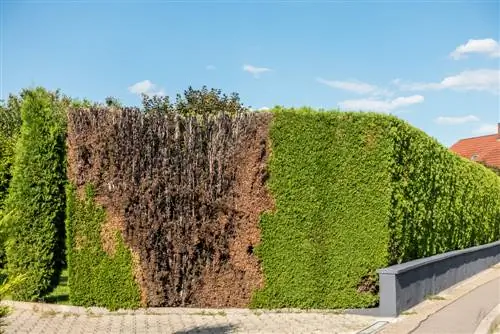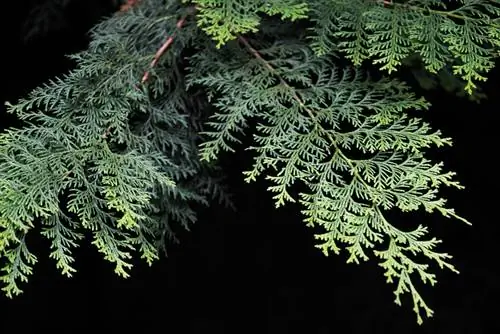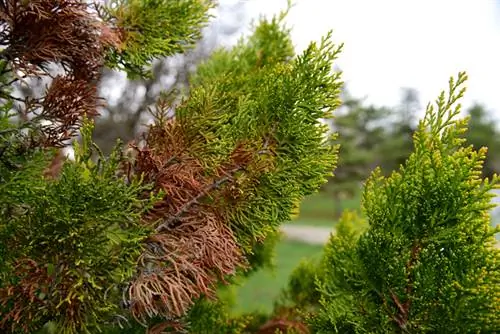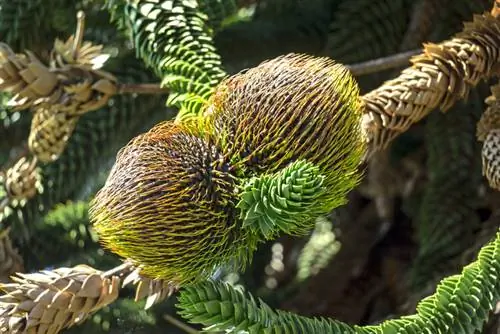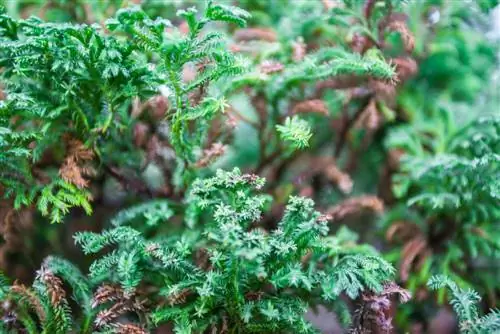- Author admin [email protected].
- Public 2023-12-16 16:46.
- Last modified 2025-01-23 11:21.
In contrast to a bulky garden fence, a hedge is a beautiful property boundary and an effective privacy screen. Especially in the summer months, shrubs and trees ensure that the garden is lushly greened. It is completely normal for plants to shed their leaves in autumn. But if your hedge turns brown in the warm season, the cause could be pest infestation, diseases or incorrect care.
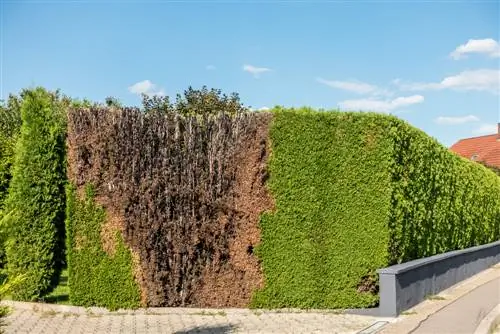
Why is my hedge turning brown and what can I do about it?
If a hedge turns brown, there can be causes such as natural browning, fertilizer and road s alt, drought, acidic soil, disease or pest infestation and root rot. Depending on the cause, measures such as pruning, irrigation, soil improvement or pest control can help.
Possible causes
- natural brown coloring
- Fertilizer and road s alt
- drought
- Acid soil
- Disease infestation
- Pest Infestation
- Root rot
Troubleshooting Tips
Natural brown coloring
If the needles of your hedge turn red-brown towards winter, there is no reason to worry. This is a natural process to prevent the freezing temperatures of winter. When frost arrives, the discoloration stops and needles may fall off. However, some cultivated forms are now evergreen.
Fertilizer and road s alt
Hedges are very sensitive to s alt. Blue fertilizer in particular increases its content in the soil. If the branch tips near the ground turn brown even though you don't use fertilizer, road s alt could be to blame for the poor appearance. In this case, cutting back the brown shoots helps. Then give your hedge a good shower with clean water.
drought
The unwanted symptoms also occur when exposed to intense sunlight and not enough water. In this case, increased watering obviously helps.
Acid soil
A high concentration of manganese in the soil also harms your hedge. To balance the acidic pH, do the following:
- Mix soil with carbonate of lime
- After three months, pile up fresh compost
- Test pH to be on the safe side
Disease infestation
Various types of fungi can be fatal to a hedge of conifers:
- Pestalotia shoot death
- Didymascella thujina
- Kabatina drive death
All three species usually manifest themselves in the formation of small black fruiting bodies on the needles. If your hedge is in the shade, it is particularly vulnerable, as are very old plants. Timely detection of the disease is particularly important, as otherwise the fungus will spread to nearby plants. Cut back your hedge radically and remedy the symptoms with a suitable remedy (€11.00 on Amazon) from specialist retailers. A humus-rich, loose soil serves as prevention.
Pest Infestation
A hedge is particularly susceptible to three types of pests:
- Bigmouth Weevil
- leaf miner
- Thuja bark beetle
The first two parasites can be treated with nematodes or vigorous pruning. In the latter case, the only solution is to dispose of the infected bush, as the beetle eats its way into the trunk.
Root rot
It is considered the most dangerous disease of a hedge and in most cases leads to the complete death of the plant after the branches initially turn brown. To avoid widespread spread, you must remove affected trees immediately. Also change the substrate, as root rot stays in the soil for a long time.

